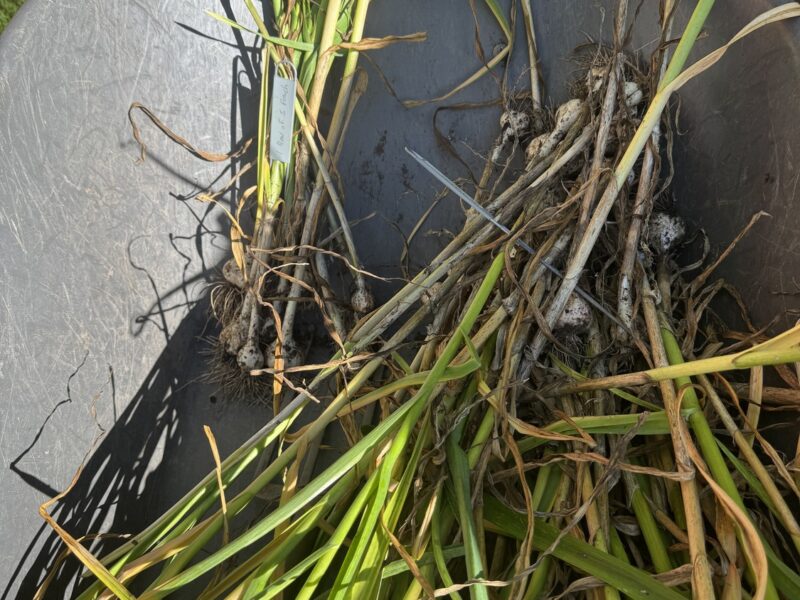

I was so busy with other pursuits early in the summer that there were a number of things that never got planted.
Basil never made it from cells into the garden, save for one plant that has thrived in the summer heat. I didn’t sow any tomato seeds, but neighbors gave me a couple of plants that are now fruiting. Broccoli is still in cell packs, as are Brussels sprouts. A few epimediums are still in nursery pots, and I never did get my steel rebar into the garden for my second clematis triangle. And six new iris varieties from Oregon arrived yesterday.
That’s the bad news. The good news though, for you as well as me, is that we’re just about at the time when many of these can be planted again, and just about any plant that’s been grown in a nursery container — those black plastic pots — can still be planted, as long as you pay attention to the ones that are root bound and needing teasing out as they’re planted.
It’s also time to do your seeding, several times, for cool season crops like spinach, lettuces and other greens. More on this below.
Garden centers are aware of this second planting season and, shortly, they’ll fill up with new nursery stock (potted), cell packs, and pots and pots of mums, asters and other perennials that can still be planted in time to establish good roots for overwintering.
No garden? No problem. You can still sow salad greens in pots, planters and raised beds, so we’ve got you covered there, as well.
If you’ve got some cell packs of broccoli and Brussels sprouts that you didn’t get into the ground, you can still plant them and hope. Some may work out and be productive, but as insurance, look for the cell packs showing up at garden centers to supplement what you already have and guarantee at least some production, or as much as you want. Remember that late planting like this eliminates many of the disease and insect problems that show up from spring and early summer plantings.
Spinach is always a crop that I plant several times from seed, from early August through the end of the month. You can choose varieties for total cutting, just leaf picking, or both. The best part is that spinach is pretty frost resistant and will continue to grow well into late October and November without being damaged. You can even grow your spinach in low tunnels well into December, while some varieties can be overwintered under hay or straw for winter harvesting, but you won’t get those tender leaves that you like from spring and early fall harvests.
For lettuces and other salad greens, I don’t go for individual plants for fall harvesting. Rather, I plant long rows of seed mixes from Johnny’s Selected Seeds every five to seven days. As these plants emerge, some will get thinned, leaving the others for later harvest. But I do love the tender new growth, so some rows are cut a few times a week (this does leave new sowing opportunities as well), keeping the harvest growing for weeks and weeks.
Radishes of all kinds can also be planted on a regular schedule for the next eight weeks for harvesting through October. Keep in mind that radishes, depending on the variety, take 30 to 50 days to mature based on the variety. They don’t get as hot or spicy as the ones harvested in late spring and early summer, and they are not subject to the flies that lay the eggs that result in the radish maggots.
Some plants don’t favor a second season of planting and seeding. No more tomato planting, no more vines like cukes, zukes and melons, as they prefer the weather getting warmer, not cooler, but continue to allow your existing vines to grow and produce. If the foliar diseases and insects haven’t done in your summer plantings, they will continue to flower for a few more weeks and that results in zukes and cukes into September.
You can also sow some seeds now for some garden plants that will flower in the spring. Viola and pansy seed can be sown over the next few weeks either in a holding bed or right in the garden, in situ. When seeded in a holding bed or nursery, you can sow the seeds in a circle or square of about 4 to 6 inches, and allow the seed to germinate and grow in place. In the early spring, you’ll have nicely formed mounds that can be easily lifted and planted into other areas of the gardens and planters. In doing this, you can choose which varieties (colors and flower styles) you want to grow and most seed houses still have these seeds available. Get them planted by the end of August, though.
As for trees, it’s a risky time to dig and move any deciduous variety. This is generally done as the leaves fall in the months to come. I’d be wary of planting balled and burlapped trees now; wait to buy and plant these until the heat is over and rain becomes more reliable.
The exceptions are trees and shrubs grown in containers. These can be bought and planted just about any time during the growing season, as there is little transplant shock from unpotting and planting them. Pay attention to opening the root mass though and water them well into the fall. No fertilizer until next year. Most years I caution against such purchases this late in the season, but we’ve had enough rain to insure that, along with irrigation, these nursery plants should do well.
You may also luck out at some garden centers when it comes to perennials. While what’s left in 1- and 2-gallon containers may look a bit scruffy, many like daylilies and hostas may be large enough in the pots so you can divide them before planting. In addition to getting an end-of-season discount, you end up with the potential of two plants for the price of one.
And speaking of hostas, if you have any of these that have finished flowering, but have very large and dividable crowns, now is the time to dig them, split them and replant the dividends. We’re also within a few weeks of peonies dividing and transplanting. If you’ve got large clumps that you want more of, or if the clumps have stopped or reduced flowering, it’s time to divide and transplant.
Use a fork, not a shovel, to get the root mass out of the ground, then divide the peony mass into three or more eye divisions. Replant so the roots are just showing at the soil surface. Plant them too deep and they won’t flower.
Hostas, on the other hand are much more tolerant of planting depth — just not too deep. A simple rule of thumb for dividing and moving perennials: If they flower late in the summer, divide them early in the spring, and if they flower from spring to early summer, divide them now. Of course, there are lots of exceptions.
On July 23, I bit the bullet and dug my garlic patch, but I had an ulterior motive. Yes, the garlic was ready, and it’s now hanging in the barn to cure for several weeks. Once the curing is done, I choose the heads that yield the bulbs for next year’s crop, then divide the cloves and replant them in early October. However, the space that the garlic gave up, about 5 feet wide and 15 feet long, looked to be a perfect spot for late summer and fall greens.
It was really hot after the garlic harvest, so I left the soil alone for a few days. When it cooled, I added some organic fertilizer to the bare soil, then worked it in. Once the soil was raked smooth, I made lines half the length of the plot and in very shallow furrows planted rows of several lettuce mixes. These will be harvested in about three to four weeks using shears, as most will regrow for a second crop.
The other half of each row will be sown shortly with several types of smooth leaf spinach. I try to carefully space these seeds so that each emerging seedling can be allowed to grow a bit. After a few weeks, every other seedling will be pulled for salad use while the remaining seedlings will be allowed to grow and be harvested through September and October. If the plan works, we’ll have all the greens we need until November in just 75 square feet. Not too late for you to do the same and keep in mind that the East End growing season can extend into early November — and, if you use row covers, even longer.
Keep growing.
GARDEN NOTES
On a cooler day last week, I did some spraying with my new Petra sprayer and my rave review stays in force. I was after powdery mildew on several varieties of tall garden phlox (Phlox p.) and used a mixture of one tablespoon of baking soda with just a bit more than one teaspoon of Sunspray oil. There is a tiny bit of residual effect from the oil, but this is the second time I used this recipe, and it seems to stop, but not cure, the powdery mildew.
I also applied it to some roses. It was 64 degrees and partly cloudy, so I wasn’t concerned with the oil and the heat. The sprayer handled the mixture with no issues, and Petra has also told me that, if properly diluted, the sprayer will also handle cold-pressed neem oil, which was good to hear.
 More Posts from Andrew Messinger
More Posts from Andrew Messinger